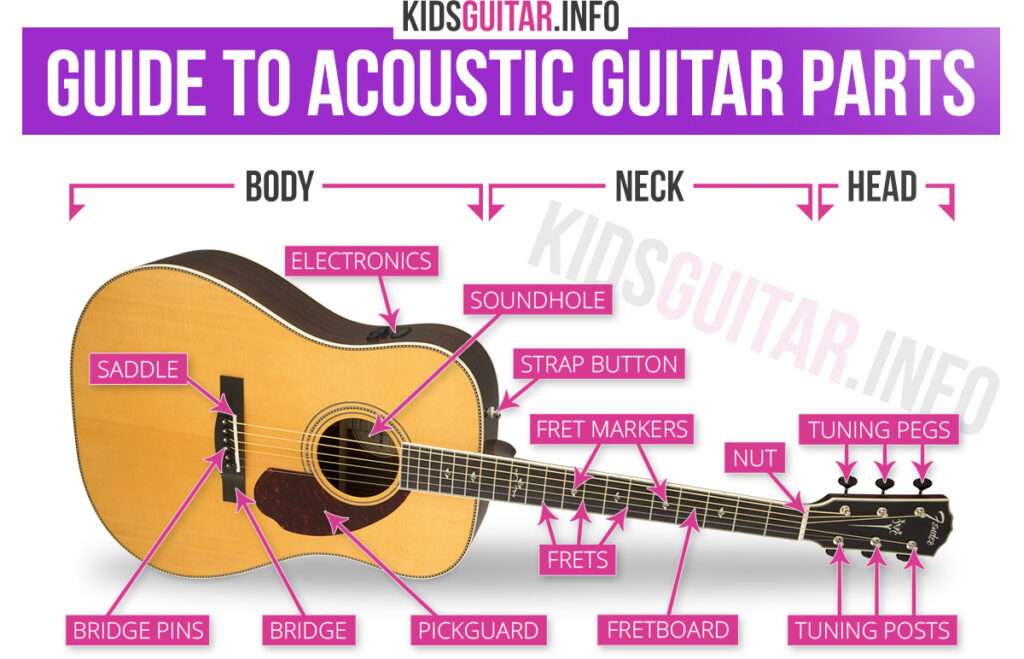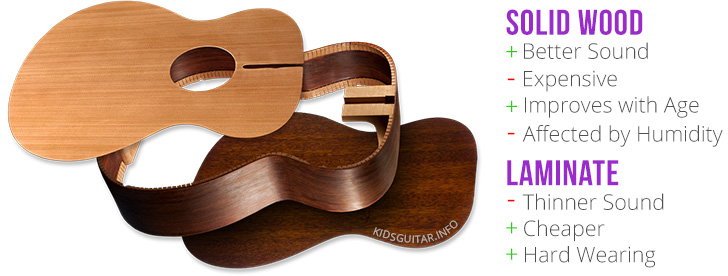Looking for information on the various different parts of an acoustic guitar? Take two minutes to absorb our beginner guide and you’ll be an expert before you know it!
If you’re looking to buy your first acoustic guitar, then you could do worse than to check out our popular beginner buyer guide.
Get a quick overview of the names of the main parts of an acoustic guitar by checking out the acoustic guitar parts diagram below.

Parts of an Acoustic Guitar
The Body
Let’s start off by looking at what forms the main parts of an acoustic guitar – the body.
Bridge
The bridge is a thin strip of material where the strings are clamped to the body of the guitar. Although usually made from woods such as Rosewood, on cheaper guitars the bridges may simply be constructed of plastic. The material used will impact the tone of the guitar to a degree, so it is preferable to have a good quality wooden bridge to help transmit the sound.
Saddle
Slotted into the bridge is a slim strip of material known as the saddle. Its function is to hold the strings at a certain distance from the body, as well as making sure that intonation is correct. The height of the strings can be adjusted by either adding thin shims of extra material underneath the saddle, or by carefully filing the bottom with sandpaper. Saddles are most commonly made from either bone or plastic, with the former generally being preferred.
Bridge Pins
Although not used on every guitar, bridge pins are the most common method of securing strings into the bridge. Simply insert the string into the bridge hole and then insert a pin to hold it in place. They are commonly made from plastic or bone, with ebony being another popular choice. These also affect the tone of the guitar to a degree, and as they’re so cheap and easy to upgrade, it is worth doing if you are currently stuck with plastic.
Soundhole
Also known as the devourer of picks! As you can probably guess, the soundhole plays a large part in the type of tone that your guitar will produce. The size and shape of the hole will affect the balance of bass and treble tones emitted. Although most commonly a large circular opening in the center of the guitar, many other designs are utilised by different companies. For example, check out an Ovation guitar, where you’re likely to see a pattern of several smaller circular openings instead.
Pickguard
Also known as a scratchplate, most acoustic guitars will come with a pickguard applied. As well as being an aesthetic feature of the guitar, it also helps to protect the body finish from scratches made by over-zealous picking and strumming. The most common styles are either plain black, or a tortoise-shell pattern as shown in the image above.
Electronics
If buying an electro-acoustic guitar, you’ll also get a few other bells and whistles in the form of added electronics. This will vary from one instrument to the next, but generally this means that you will have some form of Equaliser (EQ) to allow you to shape the plugged-in tone of the guitar. Often a built-in tuner will be added to allow you to easily tune without the need for an external tuner.
Strap Pegs
Finally, the strap pegs are two little metal objects that you attach your guitar strap to. On some guitars you might only be given a rear strap-peg, making it necessary to attach one end of your strap the the headstock instead.
Top, Back and Sides
Although there are many more parts which make up the body, the three main sections which form the body are known as the top (or soundboard), the back, and the sides – shown below in a handy diagram. These parts can either be made from laminate or solid woods.

On budget guitars, all of the three sections will generally be made from laminate, i.e multiple thin layers of wood fused together. As we move up the price ladder we start to see guitars with solid wood tops and laminate back and sides. And eventually, on higher-end instruments, all sections will be constructed of solid wood.
The advantages and disadvantages of laminate and solid wood are shown in the diagram above, but as a general rule of thumb, solid wood is the better option due to the improved tone it produces.
The Neck
Fretboard
Also known as the fingerboard, the fretboard is a long strip of material (usually wood) which sits on top of the neck. The most common types of fretboards are made from rosewood or ebony. Some fingerboard might be bound in white plastic (as seen in the picture at the top of this page) to help protect the edges – plus it looks cool!
Frets
The fingerboard is divided up into several sections, defined by the frets. These strips of metal wire run across the fretboard at set intervals and are most commonly made from nickel or brass, although pricier alternatives such as stainless steel are available. Poorly levelled frets will cause unwanted string buzz, so it is important that all frets should be level and also smooth at the edges.
Fret Markers
Most guitars will feature fret markers (also known as position markers or inlays) at certain intervals on the fingerboard so that you can quickly tell which fret you are playing on. The design can be anything from simple dots, to extravagant sprawling vines covering most of the fretboard. They are most commonly made from mother-of-pearl or abalone. Be aware that some guitars do not have them, forcing players to instead rely on side dots on the neck to relay positioning.
Nut
The nut is a thin slotted strip of material between the fretboard and headstock which the strings rest on. Its purpose is to keep the strings separated at the correct distance, as well as at the correct height from the fingerboard. An acoustic guitar nut is most commonly made from bone or plastic blends.
The Headstock
Tuning Pegs
Also called tuning knobs, tuning keys or machine-heads, the purpose of the tuning pegs is to tighten and loosen each string in order to obtain correct pitch. Good quality tuning pegs will make tuning much smoother when compared to cheaper options where string breakages are also more likely. Although some really cheap guitars will use *shudder plastic tuning pegs, better options are chrome or nickel.
Tuning Posts
This is the parts of an acoustic guitar tuning mechanism which protrude on top of the headstock. The strings are inserted into a small hole in the middle of the post and then wound round several times until correct pitch is achieved. On cheaper guitars the sharper, unfinished edges on these might lead to excessive string breakages, so it is worthwhile investing in a good set of tuners as it may end up saving you money in the long term.
In a nutshell, that should cover most of the parts of an acoustic guitar. I hope it helped you to understand this fantastic instrument a little better!



